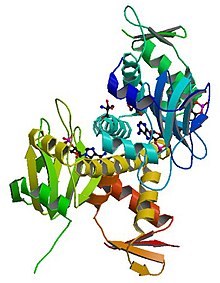|
CAMP receptor protein
cAMP receptor protein (CRP; also known as catabolite activator protein, CAP) is a regulatory protein in bacteria. ProteinCRP protein binds cyclic adenosine monophosphate (cAMP), which causes a conformational change that allows CRP to bind tightly to a specific DNA site in the promoters of the genes it controls.[1][2] CRP then activates transcription through direct protein–protein interactions with RNA polymerase.[1][2] The genes regulated by CRP are mostly involved in energy metabolism, such as galactose, citrate, or the PEP group translocation system.[3][4] In Escherichia coli, CRP can regulate the transcription of more than 100 genes.[5] The signal to activate CRP is the binding of cyclic AMP. Binding of cAMP to CRP leads to a long-distance signal transduction from the N-terminal cAMP-binding domain to the C-terminal domain of the protein, which is responsible for interaction with specific sequences of DNA.[6] At "Class I" CRP-dependent promoters, CRP binds to a DNA site located upstream of core promoter elements and activates transcription through protein–protein interactions between "activating region 1" of CRP and the C-terminal domain of RNA polymerase alpha subunit.[1][2][7] At "Class II" CRP-dependent promoters, CRP binds to a DNA site that overlaps the promoter -35 element and activates transcription through two sets of protein–protein interactions: (1) an interaction between "activating region 1" of CRP and the C-terminal domain of RNA polymerase alpha subunit, and (2) an interaction between "activating region 2" of CRP and the N-terminal domain of RNA polymerase alpha subunit.[1][2] At "Class III" CRP-dependent promoters, CRP functions together with one or more "co-activator" proteins.[1][2] At most CRP-dependent promoters, CRP activates transcription primarily or exclusively through a "recruitment" mechanism, in which protein–protein interactions between CRP and RNA polymerase assist binding of RNA polymerase to the promoter.[1] References
|
||||||||||||||||||||||||||
